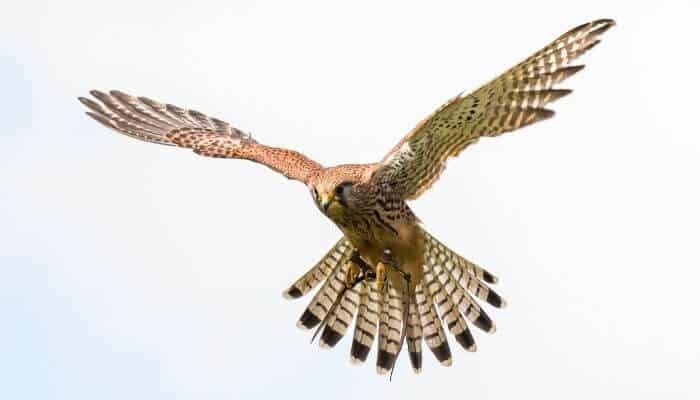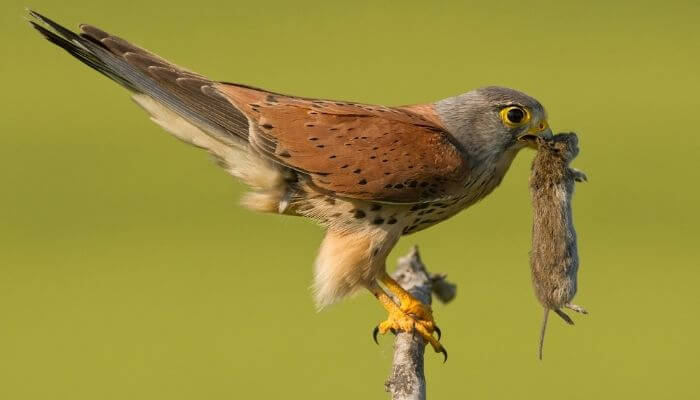Kestrels are a bird of prey and a type of falcon.
This means they follow a carnivorous diet with mouse-sized prey their favoured meal, but they can and will catch and eat pigeons and other birds.
Some birds are better equipped to be hunters and that is the case with the raptor family.
It is all down to position in the food chain and carnivorous kestrels are higher up the chain than the pigeon.
Do Kestrels Eat Other Birds?
Alongside small mammals, another animal group that can make up a considerable portion of a kestrel’s diet are small birds.
In particular, kestrels have been cited as being effective hunters of birds that fall under the ‘passerine’ label.
You might think that narrows things down, but passerines make up more than half of all the bird species!

An easy way to tell a passerine apart from a non-passerine is the arrangement of their toes, in which three-point forwards and one backwards. This helps them to perch, as they are all comfortable perching birds.
Some of the birds that kestrels eat include:
- Starlings
- Meadow Pipits
- Robins
- Sparrows
- Collared Doves
- Turtle Doves
- Skylarks
- Swifts
- Young blackbirds
In most environments, small birds make up more of the kestrel’s diet during late spring when there is an abundance of fledglings ill-equipped to protect themselves against a swift raptor.
Do Kestrels Eat Pigeons?
So if it’s established that “small” is the unifier among the common prey of the kestrel, where do pigeons fit in?
The first question is whether or not a pigeon is a passerine. The answer is no.
Whilst you might imagine that a pigeon falls under the passerine category because they certainly are known for perching, they boast a slightly different foot structure that prevents them from being included in the passerine list.
Another fact is that most pigeon species are deemed to be too large to be classed as a passerine.
When it comes to pigeons, kestrels certainly have the capabilities to be able to attack and kill a pigeon for food, but pigeons are a much larger target than a kestrel would usually go for.
In times of great hunger or desperation, the kestrel as a bird of prey will almost certainly take any opportunity it can to eat, and that includes a pigeon that seems an approachable size or vulnerable.
Pigeons are not among the most suitable and naturally available prey for a kestrel, and they will certainly find themselves being spared in favour of mice, shrews, voles and other small mammals if there is a choice.
Ultimately it comes down to the fact that kestrels have a wide range of choices in their diet, and among those choices, pigeons are not the most desirable or easy to obtain.
On occasion, a kestrel will almost certainly eat a pigeon if it needs to, but it isn’t a pattern of hunting that is among the most common for the breed.
Pigeons are at greater risk from other birds of prey larger than the kestrel, such as hawks and eagles.
What Is a Kestrel?
A kestrel (common kestrel specifically) is a bird of prey species that belongs to the falcon family Falconidae. It is a species that is found mostly in Europe, Asia and Africa with some on the east coast of North America.
Depending on where you live it might be called the European kestrel, Eurasian kestrel, or Old World kestrel.

In the UK where the common kestrel is the only type, it is simply a kestrel.
Kestrels are recognizable by their plumage of light chestnut brown with blackish spots on the upper side and buff with narrow blackish streaks on the underside.
They are not among the biggest of the raptors and are about the same size as a common/feral/wood pigeon.
What Does A Kestrel Eat?
The kestrel is a bird of prey, which means that it is designed to hunt small animals and feast on them rather than foraging for a vegetation-based diet.
When hunting, typically, the kestrel will hover at a height of anything from 10 to 20 metres (35-65 feet).
Thanks to its amazing eyesight, a kestrel is able to see small mammals such as mice, voles, shrews from a long distance away, biding its time before it finds the opportunity to make a steep dive and pluck the creature right out of its habitats.

Mostly, the kestrel will feed on small mammals, but its diet can consist of a mixture of the following depending on location and availability:
- Mice
- Voles
- Shrews
- Bats
- Frogs
- Lizards
- Spiders
- Beetles
- Winged Termites
- Other sizable insects.
Mice, voles and shrews will generally make up more than three-quarters of what a kestrel will eat.
Kestrels have the incredible ability to be able to see near-ultraviolet light which enables them to see urine trails around the burrows of the small mammals they seek.
